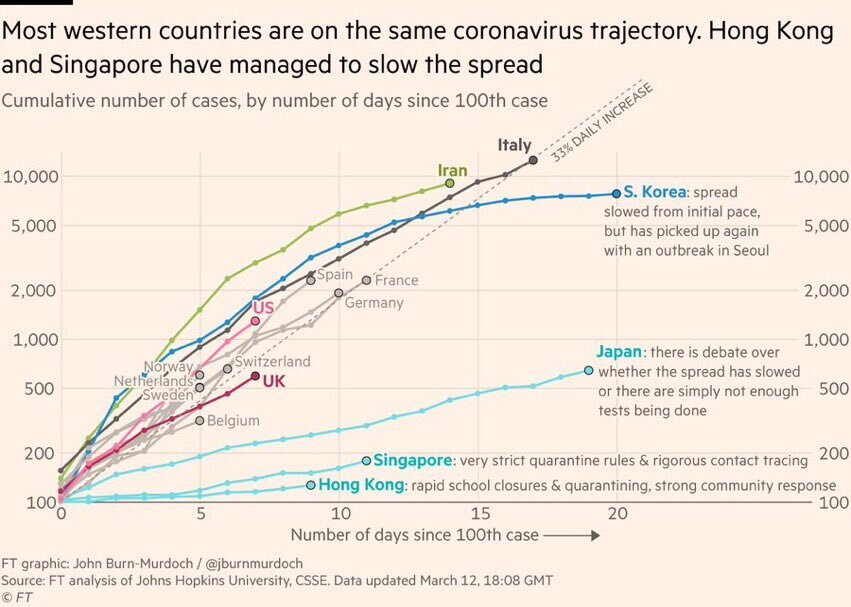Thinking about what is said in the news, in your view is the seriousness of coronavirus generally exaggerated, generally correct, or is it generally underestimated? ( 5-9 March)
Source: Axios/Survey Money. Question wording: Thinking about what is said in the news, in your view is the seriousness of coronavirus generally exaggerated, generally correct, or is it generally underestimated?
Survey dates: 3/5–3/9
I’m not an “expert” but 20 years investing in markets has taught me to be suspicious of practical behavioural insights as applied to complex systems (see Nassim Taleb for well articulated views here) and I don’t have viral pandemic modelling to hand - plus all the models have very wide uncertainty to them in the early days and are not time invariant.
Still - here are some brutal maths, counterfactuals and ideas to consider:
-a considerable number of people currently believe COVID is no worse than flu. About 1 in 3 people, I estimate. The survey above, taken around 5 March, suggests 44% of US think the risk is exaggerated.
If you look at UK data, 25% or 1 in 4 are doing nothing. Presumably these people think risk is low. Otherwise they would be doing something. 6 / 10 are improving hygiene, but that means 4 / 10 are not.
Source: YouGov, https://yougov.co.uk/topics/health/articles-reports/2020/03/13/most-britons-still-arent-scared-about-contacting-c
Trust in governments are low in Europe/US. This is true in the UK.
Source: Edelman Trust Survey (2019)
Items to consider about “herd immunity” and UK government advice, quarantines etc:
-We don’t know if people can acquire good immunity to COVID, we don’t have certainty about re-infection as yet (happy to be proved wrong here)
-We do know that “second waves” in pandemics can be worse than the first wave, but we don’t know about COVID
-We don’t know whether the UK public would listen to the UK government - a significant amount of people disbelieve the evidence on COVID
-We don’t how many people will catch COVID but show no symptoms
-We don’t know how long control measures would have to be in place, and whether when lifted, a second wave happens
-(At some point?) There is a trade-off being considered between economic growth (and its impact on social) and health outcomes
-We could assume that eventual infection rates are between 20% to 70%, with 50% infection rates very plausible. It is unknown whether social distancing will impact that number significantly.
-Is there transmission from immune people? Unknown. Maybe not.
-Can this method keep peak cases in the UK below 20,000 to 40,000, so that healthcare capacity in ICUs and ventilators is OK?
But a ‘flatten the curve’ argument (eg introduce strict social distancing policies) has 3 other points in favour:
-The delay might be enough time for a drug therapy treatment to be identified (my estimate is that we may know about efficacy for some antivirals by end April)
-We don’t know how hot weather will impact the virus. In the UK, a delay into summer or closer to summer might help
-A lower peak still helps with healthcare (ventilators and ICU beds)
Let’s look at some other brutal maths. 1 year or 2 year infection rate estimates might range from 20% to 70% of the population. Swine flu had a 20% infection rate and 150K to 575K people died (CDC data). Swine flu also circulates every year now since 2009.
A 20% infection rate seems very plausible. The case fatality rate (this is for when you are assigned as a case and so doesn’t include non-symptom or mild cases that don’t get reporting) is very hard to know.
As explained by Max Roser / World In Data , it’s not time invariant, it varies with country and many other factors.
The case fatality rate is the share who died from the disease among individuals diagnosed with the disease. The CFR is calculated by dividing the total number of deaths from a disease by the number of confirmed cases. It is expressed as a percentage and used as a measure of disease severity.
But, still a case fatality rate ranging between 0.1% and 0.5% would seem plausible, with a heavy impact to the elderly (3% to 8% CFR).
These are the brutal maths for the UK and Italy.
Italy has about 60m people and >22% are over 65 —> over 12m elderly.
If 20% are diagnosed —> 2.4m and at 4% CFR —> 96,000 deaths. It’s easy to see how this might range up to 200,000+ easily with double diagnosis/CFR.
In the UK, it’s about 18% of 67m —> this is also 12m elderly. The maths is the same, if 20% are diagnosed —> 2.4m and at 4% CFR —> 96,000 deaths.
Let’s hope the CFR comes down but it’s going to be quite sobering.
If you consider there are about 540K deaths in a year in England/Wales. This will be an excess of 15 to 20% of the annual base rate with a heavy elderly skew.
If the UK ends up with more or equal deaths to Italy given it was earlier on the curve (see above for number of cases) compared to Italy - I think the UK’s strategy may be considered a government mistake. But, if UK remains under 20K cases for an extended time, it may end up sealing another 4 years of this government.







